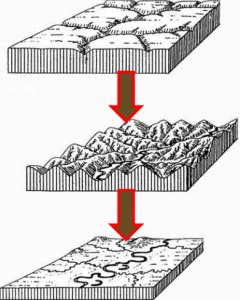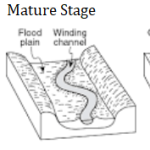To understand the concept of the cycle of landscape evolution, let us start with a relatively flat upland area in a humid region.
- During the youth stage, the area remains more or less flat. The stream valleys are generally narrow.
- In the mature stage, the land’s relief increases, and the landscape changes into one consisting of hills and valleys. The “relief” of an area may be defined as the maximum difference in elevation.
- In the old stage, the streams will approach base level, and the land will be reduced to a peneplain. The “peneplain” is an undulating plain, which lies nearly at base level. Some mounds or hillocks of hard rocks still persist. These hillocks are called “monadnocks”.
Origin of the Concept of the Cycle of Erosion:
The concept of the Cycle of Erosion originates with the theory presented by William Moris Davis. He was an American

geomorphologist, who presented his theory of landform development namely “Geographical Cycle of Erosion” in 1899, after being impressed by Charles Darwin’s theory of the “Origin of the Species”. Davis compared the evolution of landforms to the organic evolution of living beings. According to him as organic life passes through the stages of youth, maturity and old, similarly geomorphic landforms also pass from youth through maturity to the old stage.
According to the Davis Theory ‘the geographical cycle is the period of time during which an uplifted landmass
undergoes through transformation by the process of land sculpture and ending into a low featureless plain – a Peneplane.’ Davis’s Theory is also known as the “Theory of Normal Cycle of Erosion” because fluvial processes cover most parts of the globe except cold and hot deserts. Moreover, it is because of the cycle of erosion by the commonly found, widely available fluvial process or running water.
According to Davis, Landform is the function of structure, process and stage.
L= f (s,p,t) where, L is for Landform, f for function, s for structure, p for process, and t for time. Landforms develops as a result of process affecting the structure through time.
How did the concept of the Cycle of Erosion evolve?
Davisian Model
Theory of As mentioned in the above paragraph, the concept of the Cycle of Erosion evolved from the work of American geographer William Morris David, who developed the theory in the 1880s and 1890s.
-
Initial development
Davis first conceived the idea while studying the Appalachians in Pennsylvania and Virginia. His theory of “Geographical Cycle of Erosion” was first defined in his 1889 article. The Rivers and Valleys of Pennsylvania were a model of how rivers erode uplifted land to base level. It was inspired by the work of Erasmus, Charles Darwin and Jean-Baptiste Lamarck, and it had a strong evolutionary flavour. His cycle of erosion suggests that (larger) rivers have three main stages of development, generally divided into youthful, mature and old-age stages. Each stage has distinct landforms and other associated properties, which can occur along the length of a river’s upper, middle, and lower course.
-
The dominant paradigm of the Davisian Model
The Cycle of Erosion became the primary model in geomorphology until the 20th century. Though the cycle of erosion had a crucial e contribution to the development of geomorphology, many of Davis’ theories regarding landscape evolution, sometimes termed ‘Davisian geomorphology’, were heavily criticized by later geomorphologists. Even when Davis retired from Harvard in 1911, the Davisian theory had a monopoly in the study of landscape evolution. Davis was always passionate to have his theory accepted with none to defy it. He reacted violently and disdainfully to criticism, particularly the German criticism in the 1920s headed by Walther Penck. It was also his characteristic to choose to attack the most vulnerable points of that criticism. Since that time, with a less dogmatic approach and greater knowledge, some authors note that Penck’s and Davis’ ideas have become more compatible and even complementary since the advent of modern tectonic theory. They claim that Davis’ ideas are more applicable near active margins where tectonics are “cataclysmic”, and Penck’s ideas fit better in models of passive margins and continental platforms.
-
Challenges to the Model
The model was challenged by Penck’s theory of landscape development and other alternative models. Penck proposed an alternative model of geomorphological evolution called the Penck cycle. This model rejected Davis’s concept of discrete stages of erosion and instead viewed landscape development as a continuous process determined by the interplay of uplift and erosion rates.
-
DeclineThe model’s popularity declined as scientists gained a better understanding of the Earth’s crust and surface.
Walthus Penk’s Theory of Landscape Development
to be continued……


Leave a Reply